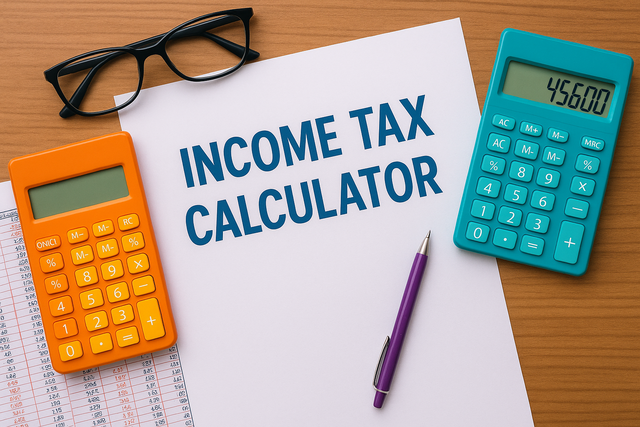
Income Tax Calculator 2025: Accurately Estimate Your Tax Liability Under New Regimes
If you want a clear, reliable picture of your tax outgo before you file your returns, an income tax calculator is your best starting point. In minutes, you can compare both regimes, check what the new income tax slab structure means for you, and plan investments to keep more of your salary in hand.
For FY 2025–26 (AY 2026–27), the Union Budget revised slabs under the new regime and expanded the rebate so that there’s no tax payable up to Rs. 12 lakh (Rs. 12.75 lakh for salaried individuals after standard deduction of Rs. 75,000). These slab changes are now part of the official Budget 2025–26 speech presented in Parliament.
Table of Content
- 1 What changed in 2025 and why it matters
- 2 How an income tax calculator helps you decide
- 3 When the new regime may be better
- 4 When the old regime can still win
- 5 Step-by-step: Use an income tax calculator the right way
- 6 Common mistakes you can avoid with a calculator
- 7 How to choose a reliable calculator
- 8 Filing tips for a smoother season
- 9 Bottom line
What changed in 2025 and why it matters
Under the new income tax slab framework announced in the Budget, rates are now:
- 0% up to Rs. 4 lakh
- 5% from Rs. 4–8 lakh
- 10% from Rs. 8–12 lakh
- 15% from Rs. 12–16 lakh
- 20% from Rs. 16–20 lakh
- 25% from Rs. 20–24 lakh, and
- 30% above Rs. 24 lakh
On top of this, a rebate removes tax liability on “normal income” up to Rs. 12 lakh (Rs. 12.75 lakh for salaried individuals due to the Rs. 75,000 standard deduction). For most households, this means simpler choices and lower tax if you opt for the new regime, something an income tax calculator can illustrate instantly.
How an income tax calculator helps you decide
A good income tax calculator does three things well:
- Projects tax under both regimes: You enter income, eligible deductions (if you’re testing the old regime), and allowances. The tool applies the current new income tax slab rates and the old slab rules to show side-by-side results.
- Factors standard deduction correctly: In the new regime for FY 2025–26, salaried taxpayers get Rs. 75,000 as standard deduction. A robust income tax calculator incorporates this and shows how close you are to the Rs. 12.75 lakh no-tax threshold for salaried individuals.
- Highlights breakeven points: By tweaking inputs, you can see where the new income tax slab beats the old regime, or vice versa, based on your deductions (PF, ELSS, housing loan principal and interest, health insurance, etc., as permitted by law).
When the new regime may be better
- Salaried income up to Rs. 12.75 lakh: You typically pay zero tax due to the new rebate plus standard deduction of Rs. 75,000. The income tax calculator will show a nil result if you only have “normal income” and no special-rate income (e.g., certain capital gains).
- Low to moderate deductions: If your usual deductions are limited, the compressed new income tax slab rates often produce a lower liability without paperwork.
When the old regime can still win
If you claim a sizeable eligible deductions and exemptions (for example, Section 80C investments, housing loan interest on a let-out property, and other permitted claims), the old regime can still deliver a smaller bill. Run both paths in your income tax calculator before you decide.
Step-by-step: Use an income tax calculator the right way
- Select FY 2025–26 (AY 2026–27). Make sure the tool reflects the latest new income tax slab rates and the updated rebate.
- Enter your salary components. Add basic, HRA, special allowance, and any other taxable pay. The income tax calculator will automatically apply the standard deduction if you toggle “new regime”.
- Add other income. Include interest, rental income, and any capital gains separately. If you have special-rate income, the nil-tax outcome under the new income tax slab may not apply to that portion.
- Test the old regime. Turn on deductions (80C, 80D, 80TTA/TTB, eligible HRA exemption, etc.) and check your result.
- Compare total tax and cash flow. The income tax calculator will show the final figure under each regime, including health and education cess, so you can pick the lower number confidently.
- Re-run for scenarios. Try annual bonus, new investments, a housing loan, or a rental arrangement to see how your tax changes under either regime.
Common mistakes you can avoid with a calculator
- Assuming rebates apply to all income: The no-tax up to Rs. 12 lakh is for “normal income”. Special-rate income (e.g., certain capital gains) is treated separately. A detailed income tax calculator models this distinction so you don’t over-rely on the rebate.
- Forgetting cess and surcharge: The final bill includes 4% health and education cess, and surcharge where applicable for higher incomes. Use an income tax calculator that applies these automatically.
- Ignoring salary structure: HRA exemptions (old regime), LTA, and perquisites can change outcomes. Accurate entry makes your income tax calculator output more trustworthy.
How to choose a reliable calculator
Pick an income tax calculator that:
- Reflects FY 2025–26 rules and the latest new income tax slab rates
- Separates “normal” and special-rate income
- Handles standard deduction (new regime) correctly, and
- Lets you download or email a summary so you can file with confidence.
Filing tips for a smoother season
- Decide your regime early. Once your income tax calculator compares both paths, declare your regime choice to your employer in time so TDS aligns with your plan.
- Keep proofs ready. If you choose the old regime, maintain receipts and statements to support deductions.
- Update declarations after life events. Marriage, a new home, or moving cities often changes your HRA, rent, or loan profile. Re-run the income tax calculator when your circumstances change.
- Check AIS/26AS. Match interest, TDS, and other items with your calculator’s inputs before filing, so there are no surprises later.
Bottom line
With the 2025 changes to the new income tax slab structure and the expanded rebate, many taxpayers will see lower or nil tax under the new regime, especially salaried individuals up to Rs. 12.75 lakh of “normal income”. A modern income tax calculator turns these rules into clear numbers, compares both regimes in seconds, and gives you a clean estimate of your final tax. Use it early, test a few scenarios, and file with clarity. The rules are simpler this year; make the most of them by running the numbers first.


